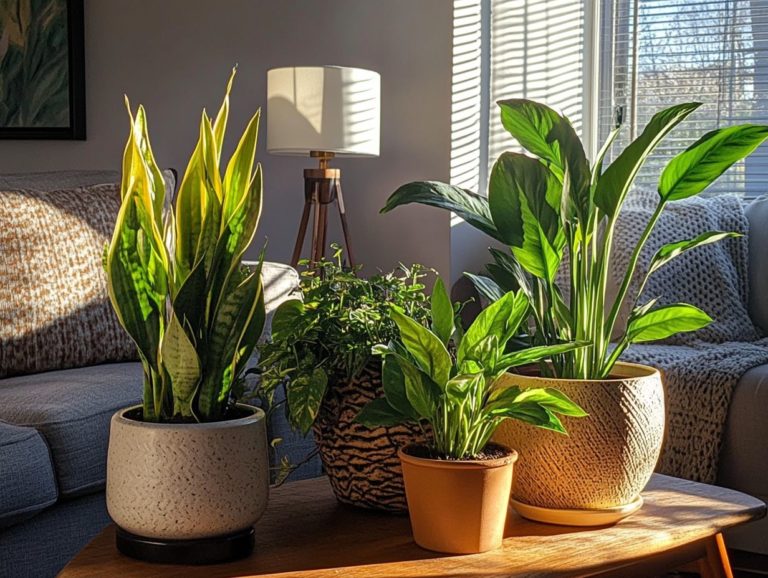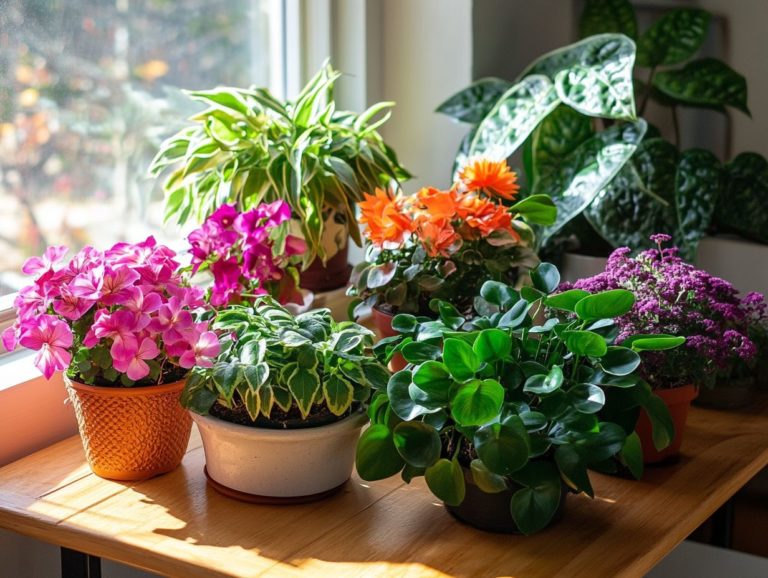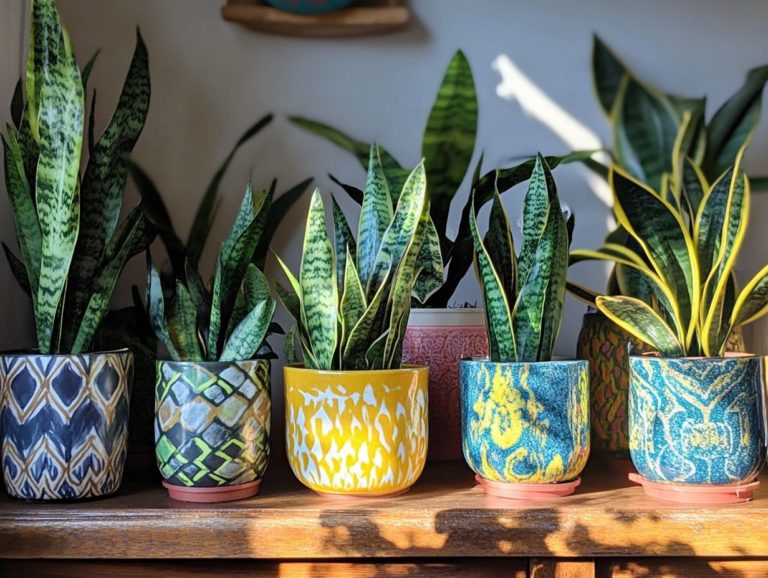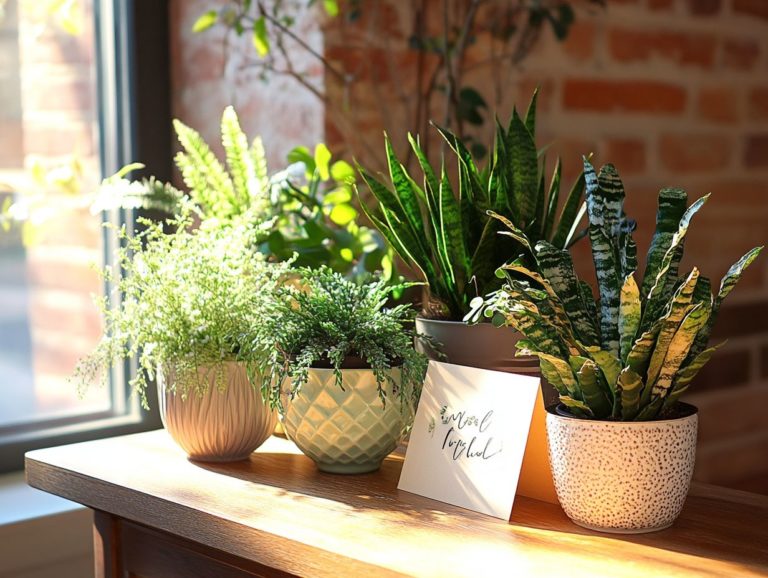Understanding the Care of Indoor Palms
Indoor palms can turn your living space into a tropical oasis. Selecting and nurturing the right variety requires a bit of know-how.
This guide empowers you to explore diverse indoor palms and choose the best one for your home. Key considerations include light and water needs, pests, and maintenance techniques.
You ll also find creative ideas for showcasing your new green companion. Dive in and uncover the secrets to thriving indoor palms!
Contents
Key Takeaways:

- Choose the right type of indoor palm for your space by considering light and water needs.
- Maintain growth conditions by providing adequate light and water. Don t forget to repot and prune as needed.
- Identify and treat pests promptly. Get creative with your palm’s styling to enhance your decor.
Types of Indoor Palms
When considering indoor palms, you ll discover a stunning variety of species. Each brings unique benefits to your home.
The Areca Palm stands out with its feathery fronds and air-purifying qualities. The elegant Parlor Palm thrives in low light, while the Majesty Palm adds tropical vibes.
Don’t overlook other noteworthy varieties like the Sago Palm, Pygmy Date Palm, Chinese Fan Palm, and Ponytail Palm. Each has specific care tips to help it flourish indoors.
Choosing the Right Indoor Palm
Choosing the right indoor palm is crucial for a thriving atmosphere. Each species has unique care requirements and environmental needs.
Consider available light, humidity levels, and the look you want to achieve. This will guide you in selecting the best palm for your indoor garden.
By understanding the specific traits of indoor palms, like their growth habits, you’ll enjoy a fulfilling plant care experience.
Factors to Consider
When selecting an indoor palm, consider key factors for healthy growth. These include light needs, humidity levels, and water requirements.
Understand the conditions in your home to choose the right palm. Choosing the right soil type and drainage system is also important.
Proper lighting is crucial. Most indoor palms thrive in bright, indirect sunlight.
For humidity, keep levels between 40-60%. Use a humidifier or a pebble tray with water near your plant for extra moisture.
Watering is important too. Let the top inch of soil dry out before rehydrating to prevent root rot, which occurs when roots decay from too much water.
Use a well-draining potting mix rich in organic matter for healthy growth. Following these tailored care tips will lead to flourishing indoor palms that enhance your living space!
Light and Water Requirements

Understanding light and water needs is essential for your palms’ growth and longevity. These elements are key to their health.
Most palm species flourish in bright, indirect light, though some adapt to lower light. Match your palm s needs with the lighting in your space.
Establish a consistent watering schedule based on each variety’s unique demands. This helps maintain optimal moisture levels and minimizes the risk of root rot.
Optimal Conditions for Growth
To cultivate the perfect environment for your indoor palms, it’s essential to maintain appropriate humidity levels while ensuring that the soil’s moisture is balanced. Most indoor palms thrive in high humidity, which you can achieve through regular misting or by using a humidity-boosting device.
Monitor the palm fronds for any signs of stress; they can offer crucial insights into your plant’s overall health and guide you in adjusting your care routine.
To further enhance humidity, try placing pebble trays filled with water beneath your pots. This method allows moisture to evaporate slowly, creating a more humid locale for your plants.
If you prefer a more controlled approach, a humidifier can help you maintain consistent moisture levels, particularly in drier climates.
Don t forget to pay attention to the soil’s moisture retention. Opt for potting soil that drains well and check the moisture levels occasionally to avoid the pitfalls of overwatering or underwatering common challenges for indoor palms.
Providing indirect sunlight will also support the balance of humidity and soil moisture, fostering lush growth and vibrant foliage.
Common Pests and Diseases
Indoor palms, despite their general resilience, can fall victim to a range of common pests and diseases. Stay alert to keep your palms thriving!
- Spider mites
- Mealybugs
These insects can cause significant damage to your palm’s health if you don t catch them early. Root rot can develop from improper watering practices.
By identifying these threats promptly, you can provide better care for your palms and foster a thriving indoor environment.
Identifying and Treating Issues
Identifying and addressing issues with your indoor palms can be remarkably straightforward when you catch the signs of pest infestations or diseases early on. Regularly inspect the palm s fronds for any discoloration or wilting. You can catch problems before they spiral out of control.
Implementing effective pest control methods and routinely cleaning the leaves can significantly boost your palm’s growth and overall vitality.
While watching for unusual spots or textures on the leaves, it’s essential to keep an eye on the soil condition. Overwatering or inadequate drainage can lead to root rot, which often reveals itself through yellowing leaves.
Tackling these issues might involve amending the soil or repotting your palm with a potting soil that drains well. For pesky infestations like spider mites or mealybugs, introduce beneficial insects or utilize insecticidal soap for effective treatment.
Creating optimal humidity and light conditions will also promote a healthier environment. This directly influences your plant maintenance routine and encourages strong, vibrant palm growth.
Repotting and Pruning
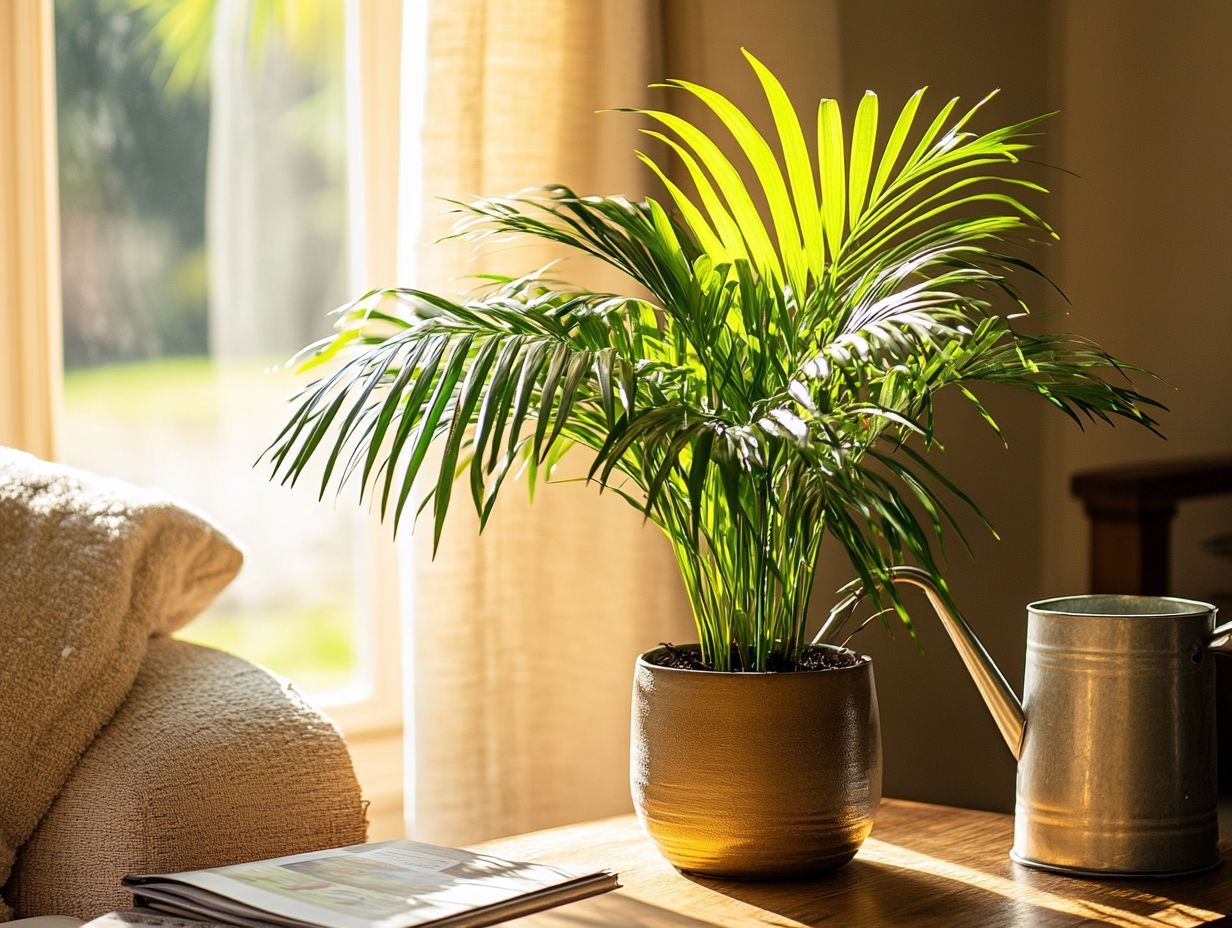
Repotting and pruning are crucial elements in the art of palm care. They play a vital role in the overall health and growth of your palm.
Knowing when and how to repot your indoor palm is essential; it ensures that your plant has ample space and nutrients to flourish.
Regular pruning helps maintain its elegant shape and encourages fresh growth. By selecting the right potting soil during repotting and adhering to proper techniques, you can elevate the ongoing care of your palm to new heights.
Proper Techniques for Maintenance
Mastering proper techniques for plant maintenance is essential for the health of your indoor palms, covering everything from repotting to pruning.
These practices not only elevate the visual appeal of your plants but also play a significant role in their overall vitality.
By establishing a consistent maintenance routine, you ensure adequate airflow around the roots. This helps minimize the risk of diseases that could hinder growth.
Incorporating organic fertilizer or specialized palm food during the growing season offers a nutrient boost that fosters lush foliage.
Pruning tidies up the plant and directs energy toward healthier fronds, encouraging new growth and ensuring your indoor palms stay vibrant and flourishing all year long.
Decorating with Indoor Palms
Decorating with indoor palms can elevate the aesthetic of your home. They infuse your space with tropical vibes that foster a serene atmosphere. Position various palm types in bright, indirect light or cluster them to create a lush indoor garden for maximum visual impact.
Employ creative styling techniques, such as choosing decorative pots and arranging them with complementary houseplants. This can further enhance the decor of your indoor space.
Creative Ideas for Styling and Placement
Let s explore how you can create a stunning palm paradise! Using unique planters, arranging palms at different heights, and mixing various species will create visual interest. Ensure you meet their light requirements to help your indoor palms thrive while enhancing your overall decor.
Incorporating elements like textured wall art and vibrant throw pillows can elevate the aesthetic appeal. Position taller palm varieties in corners or near windows to draw the eye upward and instill a sense of openness in your rooms.
Smaller palm plants can style on side tables, nestle in bookshelves, or be included in a terrarium for varied visual layers. Adding decorative stones or rustic wood bases enhances the organic feel of your arrangement, making indoor gardening a functional yet stylish choice.
Frequently Asked Questions
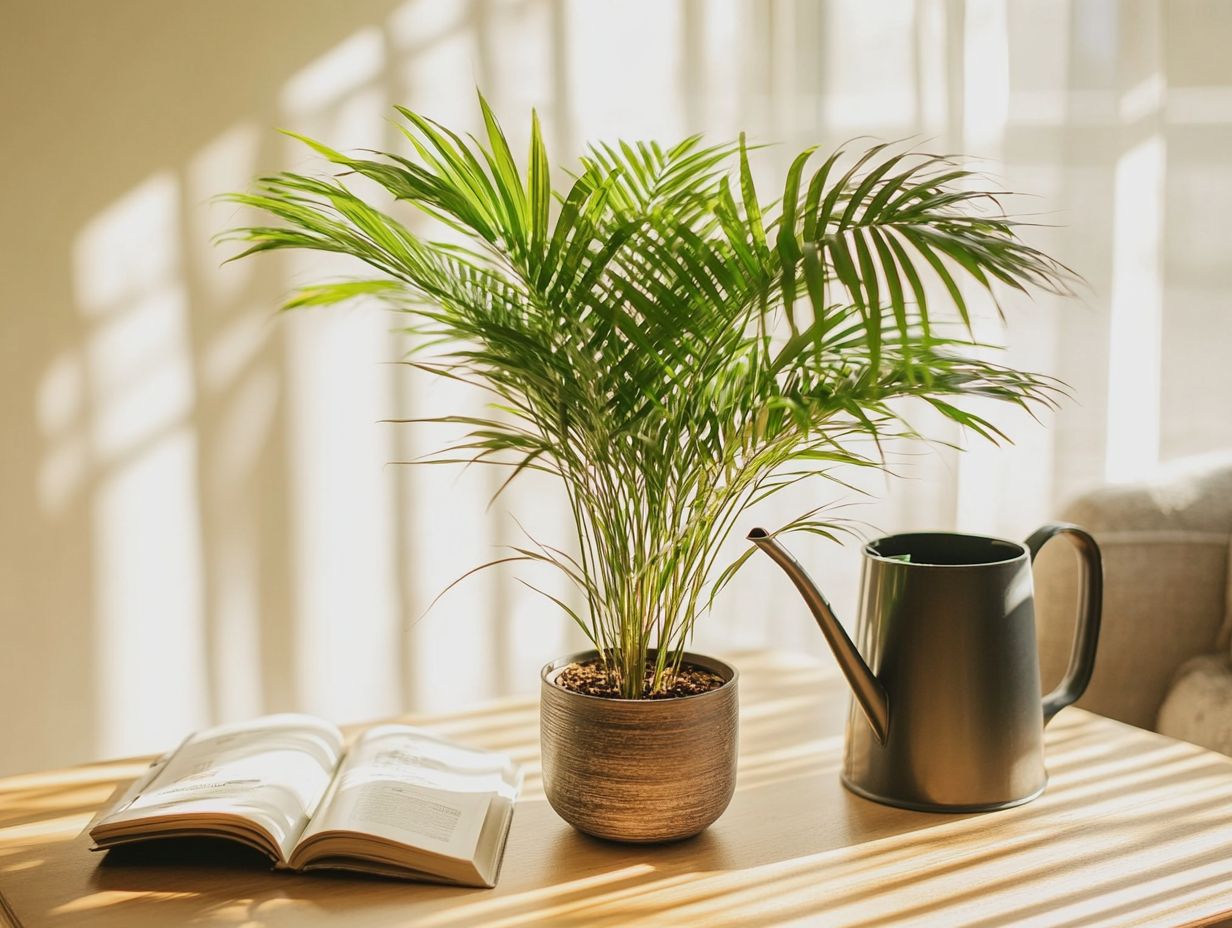
What are some tips for understanding the care of indoor palms?
To care for your indoor palms, provide the right amount of light, temperature, and water specific to your palm type. Regularly check for common bugs and dust them to keep them healthy.
How much light does an indoor palm need?
The light needed for an indoor palm depends on its type. Generally, palms prefer bright indirect light, so place them near a window with a sheer curtain.
What is the ideal temperature for indoor palms?
Most indoor palms thrive in temperatures between 65-85 F. Avoid drafty windows or vents to prevent stress and damage. Maintaining the right humidity levels is crucial as well.
How often should I water my indoor palm?
This depends on the palm type, but a good rule of thumb is to water when the top inch of the soil is dry. Use room temperature water and drain any excess to prevent root rot, which is decay of roots due to excess moisture.
Do indoor palms need fertilizer?
Yes, indoor palms benefit from regular fertilization during their active growing period, typically spring and summer. Use a balanced, organic fertilizer and follow the label instructions to encourage palm growth.
What are some common pests that can affect indoor palms?
Common pests affecting indoor palms include spider mites, mealybugs, and scale insects. Regularly inspect your palm and treat any infestations promptly to keep your plant healthy.


